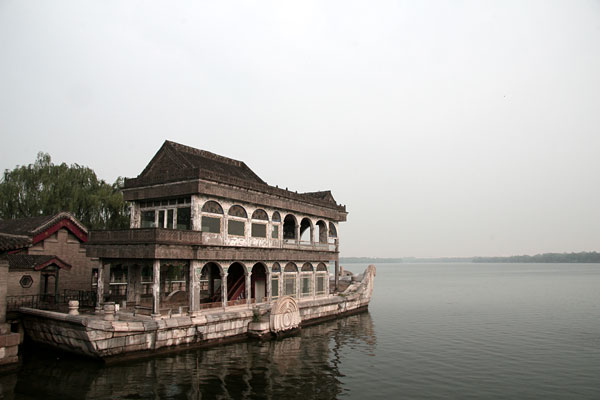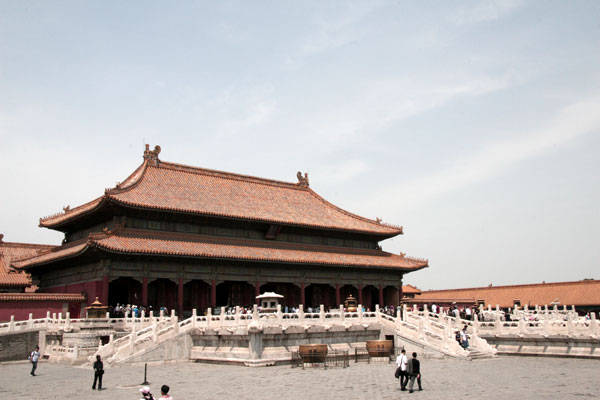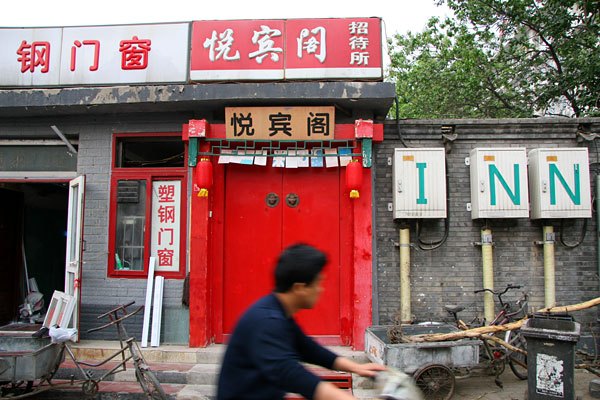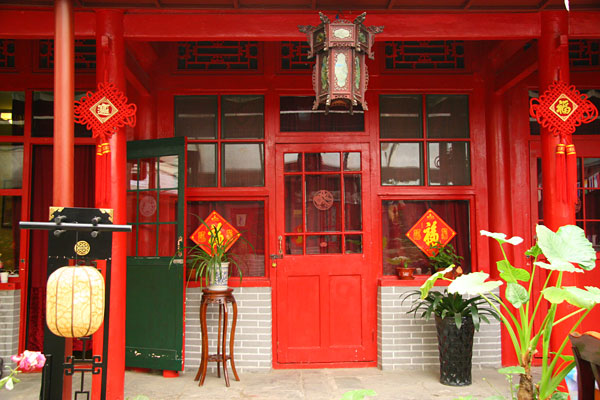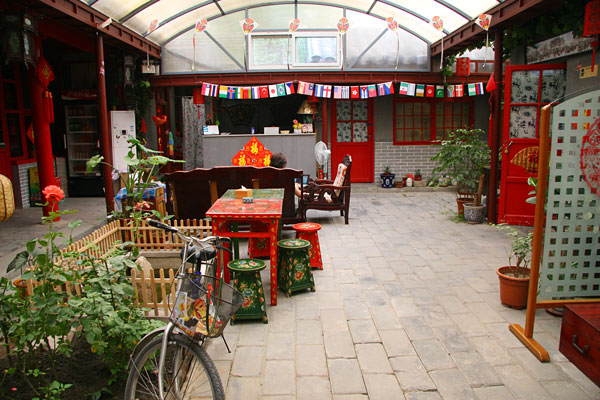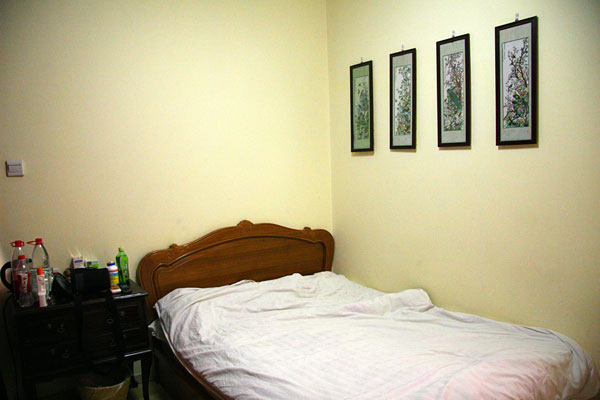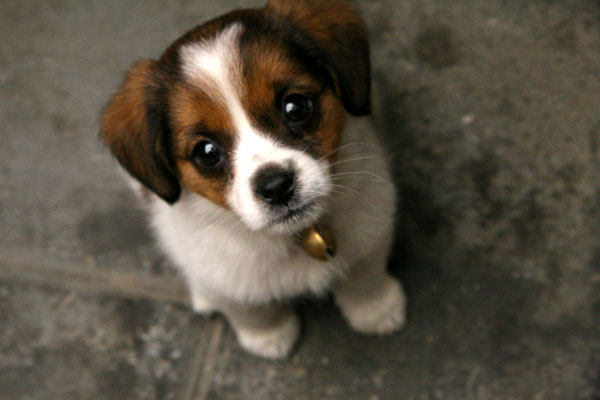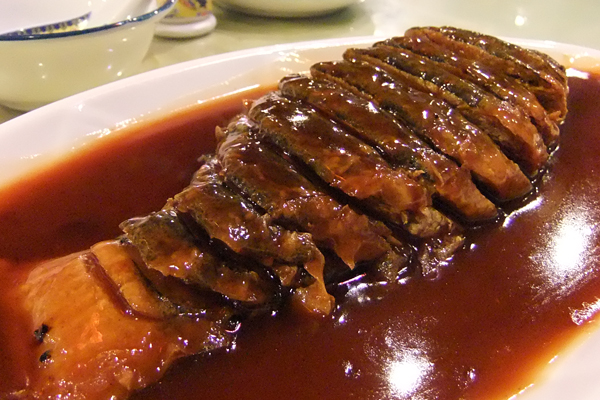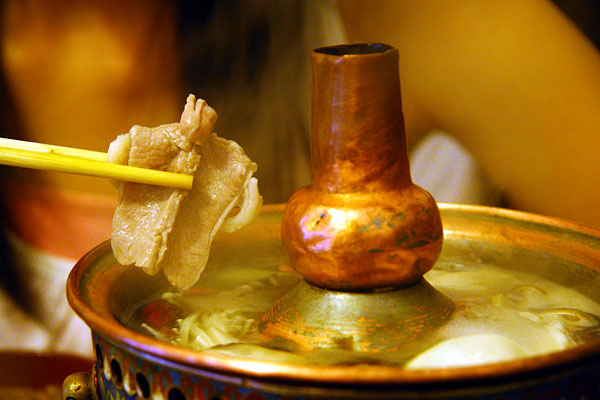
If you ask local Beijingners what dishes best represent the city, Shuanyangrou (Lamb Hotpot) would likely rank among the top. Before any lamb-shy readers get turned-off by the mere mentioning of the word, let me tell you that my wife normally doesn't eat lamb either. But this is not your regular gamey cut of mutton, as I'll explain below.
As this is a Beijing Food Trip, naturally one of our major goals was to visit one of the city's best Lamb Hotpot specialty restaurants at a reasonable price. Consulting local reviews on DianPing.com, we narrowed our list down to four candidates:
- Hongyuan: Our pick. Consistently gets excellent reviews from locals. Two of its branches are located in prime tourist areas -- one on the lakeside at Qianhai, and one just south of the Temple of Heaven.
- Jubaoyuan: Also gets excellent reviews, though its location at Niu Jie isn't the most convenient for casual tourists.
- Tianyishun: Its specialty Yangxiezi (lamb spines) gets rave reviews from locals, but it's located on the far west side of the city.
- Donglaishun: Famous as the grandfather of Lamb Hotpot chains, this 100-year-old Beijing institution seems to be avoided by local families and survives mostly on tourists and business dinners.

Food Review: HONGYUAN NANMEN SHUANROU (Houhai, Beijing)
Address: 1 Nanguanfang Hutong, Shichahai, Xicheng District, Beijing
Hours: 11:00-14:00, 17:00-24:00
Website/Map: From Dianping.com
Directions: It's on the western lakeshore of Qianhai, just south of the Yinding Bridge where Qianhai turns into Houhai. You can't miss the giant brass pot at the storefront.

We struggled between picking Hongyuan vs. Jubaoyuan, and judging from local reviews, it's probably hard to go wrong with either. But Hongyuan offers more than just great food -- it's a dinner on the lovely lakeshore of Qianhai, followed by an after-dinner stroll among Houhai's live music bars and tea cafes. It's a no-brainer.
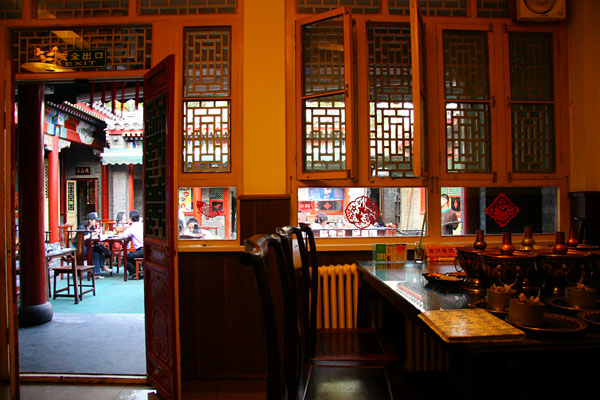
As with most good restaurants in Beijing, Hongyuan is notorious for long line-ups and we decided to come early for dinner after spending an afternoon at the Forbidden City. The restaurant is housed inside a traditional Siheyuan courtyard, where each table either shares one large communal brass hotpot or gets personal-size Cloisonne Blue hotpots. Of course, both types are traditionally shaped with the long chimneys that have become the symbol of hotpot restaurants in Beijing.

Here's my big problem though: this is a Lamb Hotpot restaurant, and my wife doesn't normally eat lamb. Baby lamb racks are okay, but anything older and more gamey turns her off just by smell alone. Any goat or mutton and she wouldn't even come near me until I rinse.

So I took the conservative route and ordered a premium platter of the freshest, never-frozen slices of beef and lamb. The choice cuts inside this Four Delicacies Platter (Sixian Pinpan, RMB 58) included (clockwise from front-left) premium tender beef, sliced beef shank, lamb neck fillet, and hand-sliced fresh lamb. I had always wanted to try lamb neck fillet, known locally as Yang Shang Nao (literally Lamb's Upper Brain, but it's actually the soft muscle at the back of the neck), and was ready to set aside the beef for my lamb-shy wife and finish all the lamb myself.
True to its legendary reputation, the neck fillet was definitely the softest cut of lamb I've ever had. It wasn't quite melt-in-the-mouth-Wagyu soft, but it was non-oily and remarkably sweet in addition to extremely tender. In fact the entire platter was excellent, but that's hardly a surprise given the restaurant's consistent popularity. The big surprise here was ...
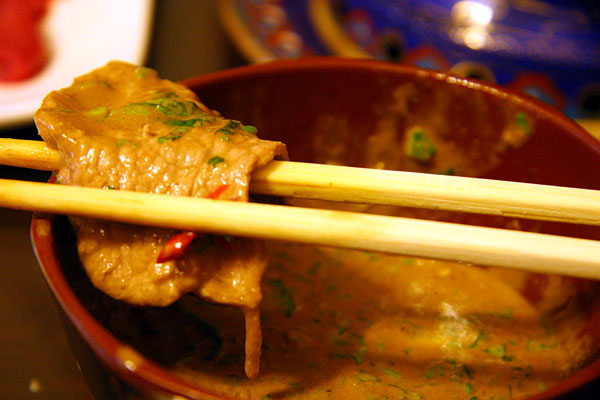
... my wife started eating lamb! She couldn't even tell the lamb from the beef as the characteristic gamey taste, the big turn-off for her palate, was entirely absent. To my astonishment half the lamb was gone within minutes, with much ending up in her hotpot! We ended up just sharing the entire platter of lamb and beef, which was all good.

To complement all the meat above we also ordered a Mushrooms Platter (Xianjun Pinpan, RMB 28), which our waitress worried we couldn't possibly finish. It was a healthy heap of Shiitake, Enoki, Yun'er (Cloud Ears), and Buna-Shimeji mushrooms, which are among our favourites in any hotpot meal. We did finish the platter at the end, though it took a while.

But the true essence of a great Hotpot meal lies inside the dipping sauce. Every respectable Hotpot restaurant in Beijing has its own so-called secret formula, which typically consists of sesame paste, fermented tofu, cilantro and chives, among other secret seasonings.
The sauce (RMB 5 per bowl) here was deliciously thick and lent an excellent rich flavour to the flash-boiled lamb, though the portion could have been a little more generous.
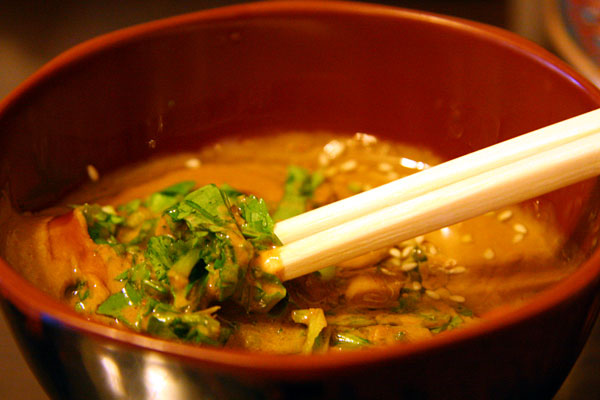
Last but not least, don't miss the free sweet-vinegared garlic cloves which come in small appetizer plates! It does take a little time to peel off the skin, but the delicious morsel inside is just the perfect palate-cleanser between mouthfuls of full-flavored lamb and rich sesame paste.
This was probably the most satisfying meal of lamb ever for myself, and an extremely rare and enjoyable one for my wife. I would encourage any reader visiting Beijing, especially those who usually dislike lamb for its gamey taste, to give this place serious consideration. Not only will you get an authentically Beijing dinner in a picturesque lakeside setting, but you may also acquire a whole new appreciation of lamb, just like my wife did.
Bill for Two Persons
| Four Delicacies Platter | RMB 58 |
| Mushrooms Platter | RMB 28 |
| Soup Stock x 2 | RMB 10 x 2 |
| Dipping Sauce x 2 | RMB 5 x 2 |
| Harbin Beer x 2 | RMB 8 x 2 |
| Table Settings x 2 | RMB 1 x 2 |
| TOTAL | RMB 134 (CAD$20.3) |
Another Northern Chinese delicacy on our radar was something every Chinese housewife makes, especially on the Eve of the Chinese New Year. No matter what you call it ... Gyoza, Kyoja, or Shui Gow ... it's a piece of mouth-watering stuffing inside a flour dough. In this part of China it is known ubiquitously as Jiaozi and, though it's often available at little informal eateries, most Beijingners would agree that mom makes the best. As I do not have a Beijingner mom, I'll just have to settle for the most famous Jiaozi chain in the region.

Food Review: TIANJIN BAIJIAOYUAN (Xidan, Beijing)
Address: 12 Xinwenhua Jie Jia, Xicheng District, Beijing
Hours: 10:00-14:30, 17:30-22:00
Website/Map: From Dianping.com
Directions:
directions: Exit Xidan subway station and walk south along Xuanwumen Nei Street for about 400m and turn right on Xinwenhua Street. Tianjin Baijiaoyuan is on the left hand side.
I have to clarify that I learned my Chinese culinary customs in the South of China where Jiaozi, or locally known there as Shuijiao, looked and tasted entirely different. I've always known Jiaozi as the bite-sized shrimp-and-bamboo-shoot dumpling with yellow, paper-thin skin and bathing in a savory broth, and have always been curious about the white, thick-skinned Jiaozi north of the Yangtze River. In this first trip to the North I was determined to find a trusted, authentic restaurant specializing in Jiaozi, just to satisfy my curiosity.

So we targeted Tianjin Baijiaoyuan, a franchised chain originating from Beijing's neighbor to the southeast. On Dianping.com it had the highest reviews from the locals among Jiaozi specialty restaurants ... and it's conveniently located at Xidan.
The first item we ordered was a pompously named Tianxia Diyijiao, or Best Dumpling Under Heaven. Affordably priced at RMB 10, it turned out to be a miserable attempt to emulate the Cantonese Shui Gow in a Northerner's menu. The mini-dumplings had fillings of minced pork/shrimp and were served in a southern-style clear broth marred by excessive MSG. That made us even more anticipative of the authentic northern Jiaozi to come.

Baijiaoyuan currently boasts 229 different flavors of dumplings, and we had the toughest time narrowing our selection down to six. Minimum order for each flavor is 2 Liang, or roughly 100g, meaning that we probably ordered enough dumplings to feed a family of four. Some of the flavors were the among the most traditional, while some were clearly not so traditional but still tasted great. Our favorites, in order of preference, were:
1) Pine Nut and Duck Egg Yolk (excellent, though slightly heavy after a few)
2) Three Delicacies (can't go wrong with tradition!)
4) Lamb and Cilantro (also excellent, especially if you love lamb)
3) Minced Mackerel (surprisingly good and less fishy than I imagined)
5) Duck and Shiitake Mushrooms (somewhat average)
6) Sablefish and Masago (unbearably fishy ... the sablefish was definitely spoiled)

What's this heinous creature in a bamboo steamer? Well it was our dessert! This was certainly not a real sea cucumber (costing only RMB 8!), but a sweet red-bean-paste filling wrapped inside a purple glutinous rice flour envelope. I guess it's probably fitting to call this a mutated Jiaozi.
It's a decent place for a casual and authentic meal if you're craving dumplings as much as I was, though we should have ordered half as much instead of stuffing myself to the neck (and still wasting a half dish at the end). If you ask about my preference of Chinese dumplings, I still like the Cantonese version in Hong Kong's street-side noodle houses better.
Bill for Two Persons
| Jiaozi (Sablefish and Masago) | |
| Jiaozi (Pine Nuts and Duck Egg Yolk) | |
| Jiaozi (Duck and Shiitake Mushrooms) | |
| Jiaozi (Lamb and Cilantro) | |
| Jiaozi (Three Delicacies) | |
| Jiaozi (Minced Mackerel) | Subtotal RMB 100 |
| Best Dumpling Under Heaven | RMB 10 |
| Sea Cucumber Dessert | RMB 8 |
| Fresh-squeezed Corn Juice | RMB 12 |
| TOTAL | RMB 130 (CAD$19.7) |

